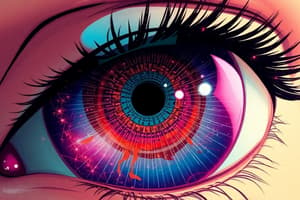Podcast
Questions and Answers
What is another term for hyperopia?
What is another term for hyperopia?
Hypermetropia or farsightedness
Explain why parallel rays of light in hyperopia come to focus behind the retina.
Explain why parallel rays of light in hyperopia come to focus behind the retina.
The eye is shorter than normal or the cornea is too flat, causing the light to focus behind the retina.
Who first suggested the possibility of hyperopia as a condition?
Who first suggested the possibility of hyperopia as a condition?
Kastner, a mathematician in 1755
What does facultative hyperopia refer to?
What does facultative hyperopia refer to?
How can hyperopia be corrected?
How can hyperopia be corrected?
What are some specific causes of hyperopia?
What are some specific causes of hyperopia?
Define axial hyperopia.
Define axial hyperopia.
What is absolute hyperopia?
What is absolute hyperopia?
Explain what facultative hyperopia is.
Explain what facultative hyperopia is.
What is latent hyperopia?
What is latent hyperopia?
Describe the symptoms associated with hyperopia.
Describe the symptoms associated with hyperopia.
What is refractive hyperopia?
What is refractive hyperopia?
Study Notes
Hyperopia (Farsightedness)
- A refractive condition where parallel rays of light coming from infinity come to focus behind the retina, resulting in blurred images.
- Can be corrected by a convex (plus) lens.
Causes of Hyperopia
- Eyeball is too short (axial hyperopia)
- Cornea is less convex or flatter (refractive hyperopia)
- Lens is less convex or too far behind the cornea
- Index of refraction: lens nucleus too low, aqueous too low, or vitreous too high
Classification of Hyperopia
- Simple: produced by normal biological variations
- Axial: eye is too short for its focal length
- Refractive: refractive system is too weak for the anteroposterior length of the eye
- Pathologic: caused by congenital and acquired elements outside normal variations
- Deformational: tumors, microphthalmos, trauma
- Curvature: cornea plana, corneal ulcers
- Index: caused by metabolic changes
- Absence of an element: aphakia
- Displacement of the lens
- Functional: due to paralysis of accommodation
Classification by Amount
- By Degree of Error (Classical)
- Low: from +0.25 to +3.00 D
- Medium: from +3.25 to +5.00 D
- High: above +5.00 D
- Sorsby's Classification
- Correlation Hyperopia: includes error up to 6.00 D
- Component Hyperopia: includes errors above +6.00 D
- By Action of Accommodation
- Total: the sum of manifest and latent hyperopia
- Latent: not revealed by customary refractive routines, caused by spasm of accommodation
- Manifest: can be revealed by routine refractive methods, may be facultative or absolute
Subjective Symptoms
- Blurring of vision
- Asthenopia (eyestrain, headache)
- Distant vision is good but the eye will soon get tired of close work
- Transient diplopia
- Drowsiness and nausea
- Feeling of fullness of head, irritability
History of Hyperopia
- Kastner (1755): first suggested the possibility of hyperopia
- Donders (1858): made a sound basis and suggested the term hypermetropia
- Helmholtz (1859): used the word hyperopia and later discarded it
Studying That Suits You
Use AI to generate personalized quizzes and flashcards to suit your learning preferences.
Description
Test your knowledge on hyperopia, also known as farsightedness, a refractive condition where parallel rays of light focus behind the retina, leading to blurred vision. Learn about the history of hyperopia and the mathematician Kastner's contributions in 1755.




